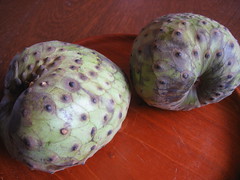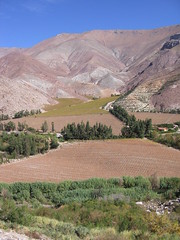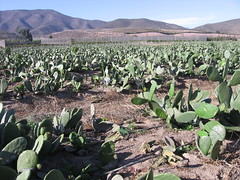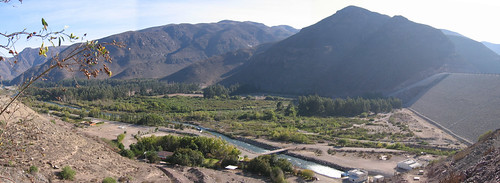The Elqui Valley
16 June 2006
4:41 PM
I dial the tour agency with a singular goal: to get information on visiting the Islas Damas, where I have read that there are penguins to be seen.
“Hola, Ecotours, Ricardo speaking.”
“Hi, I’m interested in your tour to the Islas Damas.”
“Hmm…well, the thing is that the weather isn’t good for that right now. The seas are a little rough.”
“A little rough?”
“Yeah, you know, six-, seven-foot waves.”
“I see,” I say, defeated, and ready to hang up. “Well, thanks any—”
“By any chance, can I interest you in a tour of the Elqui Valley?” I have read good things about the Elqui Valley, but I’m reluctant to sign up for something I didn’t call for. But after consulting with Elizabeth, we decide to do it. Ricardo says he’ll pick us up at our hostel in the morning.
Sure enough, as we’re eating breakfast the next morning, a large white van arrives. It’s just in time too, because I have run out of conversation topics talking to the couple from Maine who is also eating breakfast. On board we join seven other tourists, our driver Ricardo, and our energetic guide Jared. It’s going to be a packed day, he informs us.

Our first stop is a papaya and chirimoya plantation. I feel on-the-ball because I already know about chirimoya. It’s a tasty fruit native to South America that I ate with my Bolivian family all the time. It’s too delicate to ship, so you’ll rarely, if ever, see it in the U.S. Jared confirms that I know my chirimoya. But I know markedly little about papayas, so I listen intently as Jared tells us that papaya plants are actually not trees, but weeds. The juice of the unripe papaya has anti-inflammatory properties, plus you can use it as a meat-tenderizer as well. I file this away to use in case I ever barbecue next to a papaya field.
Stop two is a giant cactus field. Jared asks us why anyone would possibly plant a field of cactus. I whisper to Elizabeth, “Because of the tuna!” The cactus produce tuna, prickly pears, a fruit that’s rather tasty. Someone else in our group offers the same response—tuna, right? Wrong. The cactus are planted so that they get infested by the cochinilla worm. Once the cactus are planted, it only takes three months for them to become overrun with the worm. When that happens, the worms are harvested by hand and sent to Japan. What do those crazy Japanese want with a bunch of worms, I wonder. Jared finds a balled-up worm on one of the cactus. He crushes it between his thumb and forefinger, which immediately turn a bright, deep red. In Japan, the worms are processed to remove these pigments, which are then shipped worldwide for use in manufacturing lipstick.
Stops three and four are less interesting, though more scenic, than crushed worm pigments. We see the Puclaro Dam that dams the Elqui River for use during the region’s periodic droughts. Father upstream we see the convergence of the Elqui River with another. The merging rivers fight a colorful battle. One is a pale gray, the other a pale green because of minerals it picks up as it passes by an old gold mine. At the confluence, the green appears to be winning. Downstream, it’s more of a tie.
The Capel pisco factory in Vicuña is stop five. Picso, a kind of grape brandy, is Chile’s national drink. For pisco lovers (read: Chileans), we’re at ground zero: most of the Muscatel grapes used in pisco are grown in the Elqui Valley, and Capel is the biggest producer of pisco in Chile. Factories, with all their automation and machinery, fascinate me, and this one is no exception. Giant trucks dump loads of grapes in troughs so large that a 20-foot-tall pig could eat from them. Machines strip all the grapes from the stalks and eject the waste in a matter of seconds. The grape pulp flies around the factory in thick steel tubes. Giant silos for fermentation and storage surround the factory.
Inside the factory, we see the distillation chambers. Here, wine is boiled at 200F. At this temperature, alcohol vapors rise through the mechanism and are condensed in a separate chamber, more concentrated that before. This condensed vapor is aged in barrels before being bottled. In the next room, we have the opportunity to see the bottling floor. Thousands of red-topped bottles fly around. Each is filled in about a second, capped, labeled, packed into a box, and moved onto pallets for transport. My head spins as I watch the process.
Capel produces some 40 million bottles of pisco annually, of which only about 5% is exported. I do some quick math to learn that 38 million bottles of pisco are consumed annually by Chile’s 16 million residents (which includes babies and others who have no business drinking pisco). I guess these Chileans love their pisco!
In 1936, the Chilean government changed the name of a small town called La Unión to Pisco Elqui to link the area more closely with pisco. After winding through the valley and admiring the landscape, we finally arrived at that city for lunch, and not a moment too late after the free samples we were offered at the Capel plant on mostly empty stomachs. Lunch is the typical Chilean soup, cazuela, which tastes fantastic, as meals on busy days often do.
The afternoon is, mercifully, less busy than the morning. After lunch we wander in Pisco Elqui’s plaza and admire its quaint church. The church, I decide, holds the distinction of having the most colorful stained glass windows I have ever seen.
One of our final stops is Gabriela Mistral’s tomb. Mistal was born in Vicuña, a city in the Elqui Valley, and she became Chile’s first Nobel Prize poet. Elizabeth and I climb the steps to her headstone. As we do so, we take interest in the large amount of cactus graffiti that litters the path: people have carved their initials on the surrounding plants. The tomb itself isn’t particularly impressive, though it is marked with a fitting verse from Mistral:
Lo que el alma
hace por su cuerpo
es lo que el artista
hace por su pueblo.
What the soul
does for its body
is what the artist
does for her town.
Our final stop is the Vicuña plaza, where we rest, exhausted by the day. By the time we board the bus for our return trip at 5:30pm, we’re ready to hit the sack. We didn’t see penguins, but we saw a whole lot else. As we ride home and the sun sets, Elizabeth and I commend ourselves on a job well done: it was a stroke of luck that we went along with Ricardo and his hectic valley tour.







Comments